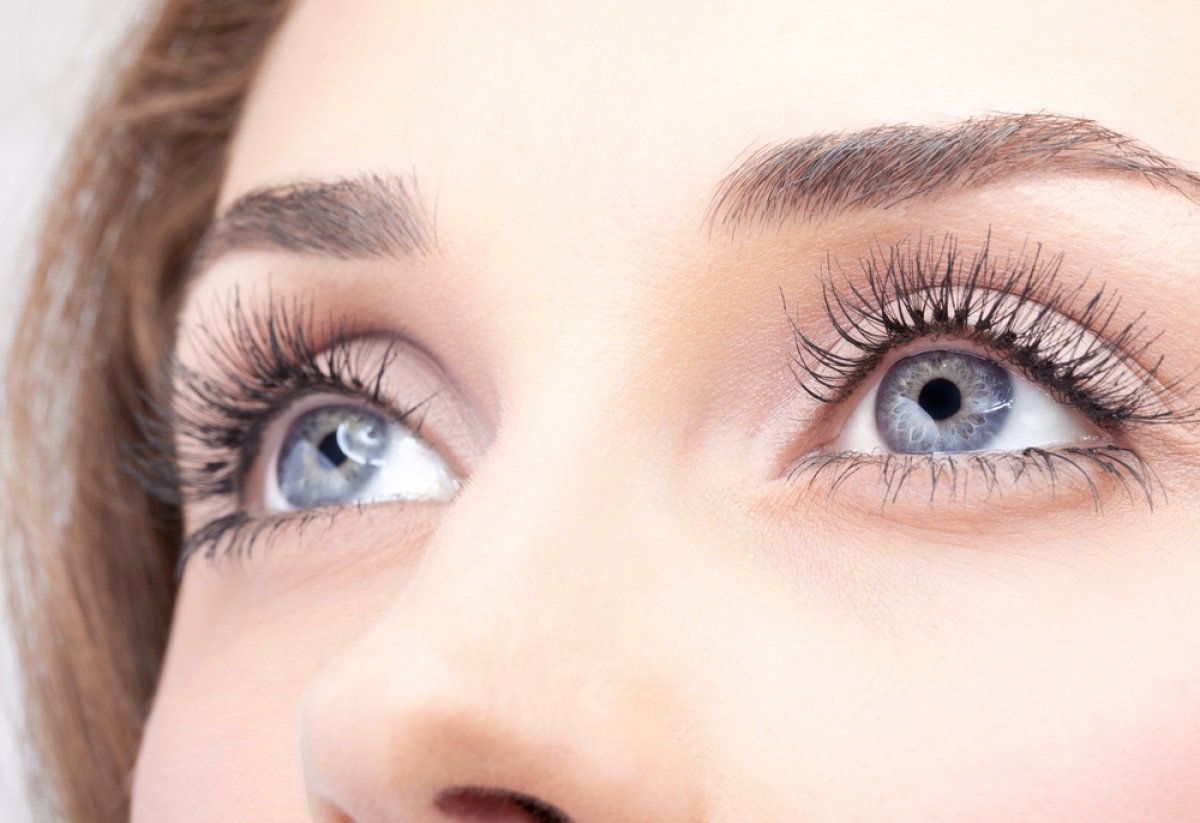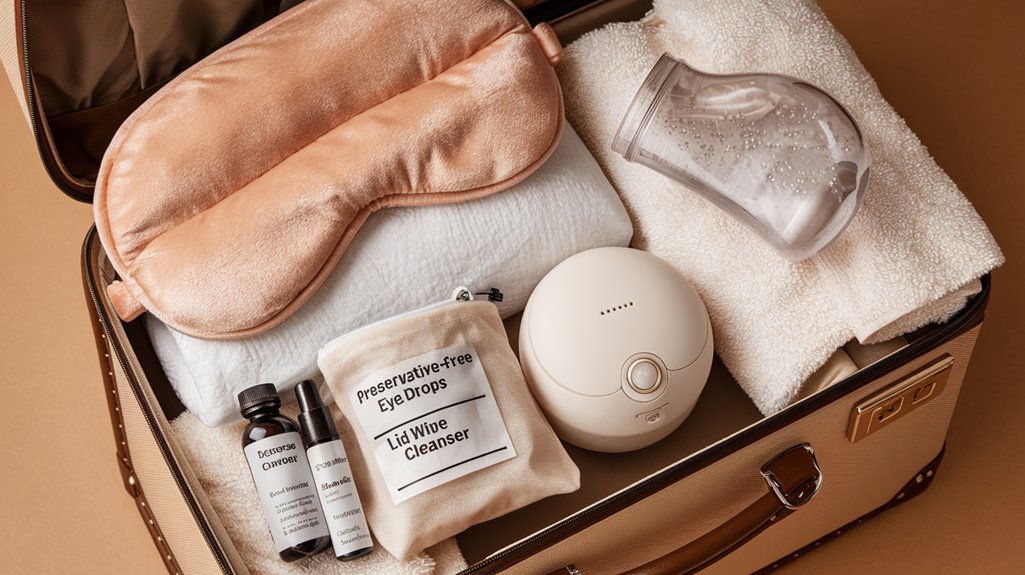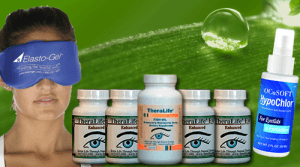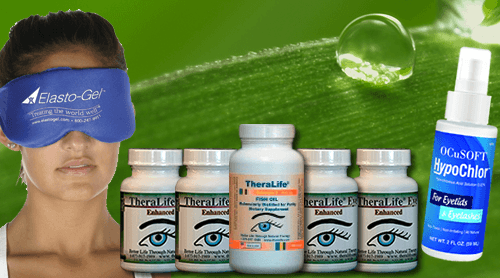To manage blepharitis during travel, consider how TheraLife’s products can benefit you. Their comprehensive range offers effective solutions for blepharitis and dry eyes, ensuring comfort throughout your journey. TheraLife provides natural treatment options that are known for reducing inflammation and improving eye health. They offer eye-optimized supplements that support tear production and relieve symptoms. For those traveling to dry environments, TheraLife’s products can help maintain eye moisture and soothe irritation.
When packing, include TheraLife’s recommended eye cleansing wipes, hypoallergenic makeup, and skincare products. Don’t forget to bring a personal humidifier for dry environments and sunglasses with UV protection. Carry lubricating eye drops in single-use vials and compact warm compresses for symptom relief. Including an extra pair of prescription glasses and a first aid kit with prescribed antibiotic ointment is also advisable. Proper preparation and the use of TheraLife’s products guarantee comfort and effective management throughout your journey.
Best Blepharitis Treatment From TheraLife
Key Takeaways
- Pack preservative-free lubricating eye drops in single-use vials for convenient relief from dryness during travel.
- Include travel-sized blepharitis-specific eye cleansing wipes to maintain eyelid hygiene and prevent flare-ups.
- Carry a compact personal humidifier to maintain optimal humidity levels and prevent dry eyes.
- Use hypoallergenic makeup and skincare products to minimize irritation from common allergens.
- Bring a battery-operated compact eyelid massager for effective eyelid cleanliness and relaxation.
Understanding Blepharitis and Its Triggers
Blepharitis is an inflammatory condition affecting the eyelids, and understanding its triggers is fundamental for managing symptoms effectively. You might experience blepharitis symptoms such as redness, itching, and a gritty sensation in your eyes.
Managing these symptoms requires careful attention to potential triggers. Environmental factors like dust, pollen, and smoke can exacerbate blepharitis, making it essential to identify and minimize exposure. Poor eyelid hygiene and cosmetic products are also common culprits that can worsen symptoms.
Implementing a trigger management strategy involves maintaining clean eyelids, avoiding particular allergens, and selecting hypoallergenic products. Tear film health is critical in maintaining ocular surface integrity and function, which can be influenced by inflammatory mechanisms in dry eye disease. When traveling, these considerations become even more important to prevent flare-ups.
Choosing the Right Eye Cleansing Wipes
Maintaining eyelid hygiene is a cornerstone of managing blepharitis, especially when traveling. Selecting the right eye cleansing wipes can help prevent flare-ups. Look for wipes specifically designed for blepharitis, as they’re formulated to effectively remove debris and bacteria. When evaluating different brands, consider the ingredients—opt for those free from alcohol and fragrances to avoid irritation. Reading product reviews is also vital; they can provide insights into the efficacy and comfort of the wipes. Some users may have sensitivities to certain components, so pay attention to feedback regarding any adverse reactions. Keep in mind that individual needs vary, and what works for one person mightn’t work for another. Prioritize wipes that are convenient for travel-sized packing. For optimal blepharitis management, consider integrating Omega-3 fatty acids into your regimen, as they offer anti-inflammatory benefits and can improve symptoms.
Selecting Hypoallergenic Makeup and Skincare Products
When selecting hypoallergenic makeup and skincare products for blepharitis, focus on identifying safe ingredients that minimize irritation. Avoid common irritants such as fragrances and preservatives, which can exacerbate symptoms. It’s essential to test new products on a small skin area before traveling to guarantee they don’t trigger a reaction. Additionally, choosing ophthalmologist-tested products can ensure safety for sensitive eyes, reducing the risk of irritation or adverse reactions.
Identify Safe Ingredients
Steering through the world of hypoallergenic makeup and skincare products requires a keen understanding of safe ingredients, especially for those prone to blepharitis.
It’s crucial to know your safe ingredient sources and practice diligent ingredient label checking. You’ll want to avoid potential irritants and focus on formulations that are less likely to cause flare-ups.
Consider the following when selecting products:
- Natural oils: Opt for those known for calming properties, like jojoba or chamomile.
- Preservative-free: Choose items that minimize preservatives, reducing risk of irritation.
- Fragrance-free: Fragrances can be irritants, so select unscented options.
- Non-comedogenic: These products won’t clog pores, lowering inflammation risk.
- Dermatologist-tested: Look for indications of testing for sensitive skin.
Careful selection can greatly prevent blepharitis complications. Maintaining eyelid cleanliness is also crucial in preventing blepharitis and ensuring that skincare products do not exacerbate the condition.
Avoid Common Irritants
Although selecting hypoallergenic makeup and skincare products requires careful attention, it’s essential to avoid common irritants to prevent blepharitis flare-ups.
Focus on products free from fragrances, dyes, and preservatives, as these can exacerbate symptoms. Opt for items labeled “hypoallergenic” or “for sensitive skin.”
Environmental factors play a significant role, so choose products that protect against pollutants and allergens.
Proper eyelid hygiene, such as regular warm compresses and eyelid scrubs, is crucial in managing blepharitis symptoms.
Personal hygiene is vital; always wash your hands before applying makeup or skincare products. Avoid sharing personal items such as brushes and applicators to minimize contamination risks.
Regularly clean makeup tools to remove potential allergens.
Test Before Traveling
Selecting hypoallergenic makeup and skincare products isn’t just about reading labels; testing before your travels can prevent unexpected reactions.
Implement effective test methods to guarantee compatibility with your skin. Conduct a patch test on your forearm or behind your ear at least a week before traveling. This approach can help you to identify any sensitivities early.
Add these test methods to your travel checklist to systematically assess each product:
- Apply a small amount and observe for 24-48 hours.
- Monitor for redness, itching, or irritation.
- Use only one new product at a time.
- Record any adverse reactions.
- Consult a dermatologist if needed.
Incorporate these steps into your travel checklist, guaranteeing your skincare remains safe and comfortable on your journey. To further protect your eyes during travel, consider incorporating good eyelid hygiene practices to help control blepharitis symptoms.
Packing a Personal Humidifier for Dry Environments
When traveling with blepharitis, packing a compact personal humidifier can help manage symptoms in dry environments. You’ll want to choose a model that’s both portable and efficient, ensuring it maintains ideal humidity levels between 30% and 50%. This humidity range is essential for preventing your eyes from becoming excessively dry and irritated. Regular eye check-ups are essential for monitoring and managing dry eye conditions effectively.
Choosing Compact Humidifiers
Maneuvering through dry environments while managing blepharitis can be challenging, so packing a compact humidifier is a smart choice.
When selecting a humidifier, prioritize travel efficiency to minimize space and maximize effectiveness. Here’s what to take into account:
- Compact Design: Opt for models that are lightweight and easy to pack.
- USB-Powered: Choose a humidifier that can be powered via USB for convenience in various settings.
- Water Capacity: Verify the tank size supports several hours of operation without frequent refills.
- Quiet Operation: Look for units that operate quietly, especially important for restful sleep.
- Ease of Cleaning: Select a design that allows for straightforward maintenance to prevent bacterial growth.
These features will help maintain comfort and manage blepharitis effectively during your travels. It’s also important to note that individuals with blepharitis may experience meibomian gland dysfunction, a condition that can exacerbate dry eye symptoms.
Maintaining Optimal Humidity Levels
To maintain ideal humidity levels while traveling, especially in dry environments, packing a personal humidifier is necessary. Dry air can exacerbate blepharitis symptoms, so guaranteeing adequate travel humidity is essential. Choose a compact, portable model that fits easily into your luggage. Regular humidifier maintenance is important to prevent bacterial growth and guarantee optimal performance. Clean the water tank and replace filters as recommended by the manufacturer. Use distilled water to minimize mineral buildup and extend device longevity. Monitor the humidity levels in your accommodation using a hygrometer, aiming for 40-60% relative humidity. Adjust the humidifier settings accordingly. In addition, be mindful that environmental irritants such as dust and smoke can further worsen blepharitis and dry eye symptoms, so maintaining a clean and controlled environment is crucial.
Bringing Along Warm Compresses for Immediate Relief
Have you considered the benefits of bringing warm compresses for managing blepharitis symptoms during travel? These are essential for providing immediate relief and can greatly enhance your comfort.
Here’s why you should include them in your travel kit:
- Ease of Use: Warm compresses are straightforward. Simply heat and apply to your eyelids for soothing relief.
- Portable Options: You can find travel-sized or disposable compresses that fit easily in your luggage.
- Reduced Symptoms: Applying a warm compress can help alleviate itching, redness, and swelling.
- Improved Eye Hygiene: They aid in loosening debris and oil build-up, promoting better lid hygiene.
- Versatile Relief: Useful for both acute flare-ups and routine care, ensuring you’re prepared for any situation.
Including warm compresses in your travel kit is a documented non-invasive treatment for enhancing local circulation and drainage of blocked glands, crucial for managing blepharitis symptoms.
Pack wisely and manage symptoms effectively.
Selecting Travel-Sized Eyelid Cleansers
When selecting travel-sized eyelid cleansers, prioritize gentle formulas to prevent irritation.
Verify the container complies with TSA regulations, typically not exceeding 3.4 ounces.
Choose reliable brands known for their safety and effectiveness in managing blepharitis.
Choosing Gentle Formulas
Selecting the right travel-sized eyelid cleansers is essential for managing blepharitis while on the go. Prioritize gentle formulas that align with your natural remedies and skincare routines.
Look for cleansers that are fragrance-free and hypoallergenic to minimize irritation. When choosing products, consider the following:
- Natural Ingredients: Opt for formulations containing chamomile or aloe vera for soothing effects.
- Non-Irritating Preservatives: Guarantee they contain safe preservatives to prevent microbial growth.
- Balanced pH Levels: Select cleansers with pH levels close to that of natural skin to maintain barrier function.
- Non-Comedogenic: Choose products that don’t clog pores, preventing further irritation.
- Dermatologist-Recommended: Use cleansers endorsed by dermatologists for sensitive eyes.
These choices help prevent flare-ups, keeping your eyelids healthy during travel.
TSA-Approved Container Sizes
To guarantee a hassle-free journey through airport security, it is crucial to adhere to TSA regulations regarding liquid container sizes. These travel liquid regulations specify that containers must be 3.4 ounces (100 milliliters) or less. When selecting travel-sized eyelid cleansers for blepharitis management, verify they meet TSA approved sizes to prevent unnecessary delays. Place these items in a clear, quart-sized plastic bag for easy inspection.
Here’s a quick reference guide:
| Product | Size (oz) | TSA Approved? |
|---|---|---|
| Eyelid Cleanser A | 3.4 | Yes |
| Eyelid Cleanser B | 2.0 | Yes |
| Eyelid Cleanser C | 4.0 | No |
| Eyelid Cleanser D | 1.5 | Yes |
| Eyelid Cleanser E | 3.0 | Yes |
Carefully selecting and packing your products in compliance with these regulations guarantees a seamless security check.
Sourcing Reliable Brands
After guaranteeing compliance with TSA liquid regulations, the next step is identifying reliable brands for travel-sized eyelid cleansers.
Sourcing reliable brands requires a focus on both product composition and proven effectiveness. Evaluating product effectiveness involves examining ingredients known for reducing inflammation and irritation.
Here’s a concise guide to assist you:
- Check for hypoallergenic ingredients: Essential for minimizing allergic reactions.
- Look for preservative-free options: Preservatives can exacerbate symptoms.
- Review clinical studies: Brands supported by research often provide better results.
- Consider user reviews: Real-world experiences can offer practical insights.
- Consult with healthcare professionals: They can recommend trusted brands based on clinical expertise.
Careful selection guarantees you maintain eyelid hygiene and manage blepharitis effectively while traveling.
Prioritizing Sunglasses With UV Protection
When managing blepharitis while traveling, it’s important to choose sunglasses with UV protection to safeguard your eyes from harmful rays.
Selecting the right sunglasses styles can greatly reduce blepharitis flare-ups. Opt for wraparound styles as they provide thorough coverage, blocking peripheral light.
Consider lens materials carefully; polycarbonate lenses are highly impact-resistant and offer excellent UV protection, making them ideal for travel. Polarized lenses can reduce glare, enhancing comfort and visibility.
Verify that the lenses block 99% to 100% of UVA and UVB rays. Also, look for sunglasses labeled with ANSI Z80.3 UV protection standards to ensure safety.
Including an Extra Pair of Prescription Glasses
Having an extra pair of prescription glasses on hand is essential when traveling with blepharitis. These additional glasses serve as a backup in case of damage or loss, ensuring you maintain ideal vision comfort throughout your journey.
Extra lenses can be a lifesaver if your primary pair becomes unusable due to an unexpected flare-up or accidental breakage. Here’s why it’s vital:
- Backup support: Prevents interruptions to your travel plans.
- Enhanced vision comfort: Maintains visual clarity without straining your eyes.
- Rapid response: Allows immediate replacement without searching for temporary solutions.
- Peace of mind: Reduces stress, knowing you have a contingency plan.
- Hygienic safety: Minimizes contact with irritants by avoiding frequent handling.
Keeping Lubricating Eye Drops Handy
Alongside carrying an extra pair of prescription glasses, keeping lubricating eye drops handy is equally significant when managing blepharitis during travel.
Eye drop types vary, but artificial tears are generally recommended to prevent dryness and irritation. Opt for preservative-free formulations to minimize potential allergens and guarantee frequent application without risk. When selecting eye drops, consult with your ophthalmologist to determine the best option tailored to your condition.
Application techniques are essential. Begin by washing your hands thoroughly. Tilt your head back and gently pull down your lower eyelid to create a pocket. Instill the drop into this pocket without touching the dropper to your eye or skin. Blink several times to distribute the solution evenly.
Repeat as necessary, adhering to the recommended dosage.
Preparing a Compact First Aid Kit for Eye Care
To effectively manage blepharitis while traveling, assembling a compact first aid kit for eye care is crucial.
Prioritize items that promote travel eye hygiene and provide quick relief during flare-ups. Include these critical components:
- Eye care gadgets: Consider a compact, battery-operated eyelid massager to maintain eyelid cleanliness.
- Sterile wipes: Individually packaged wipes are perfect for daily eyelid cleaning and maintaining hygiene.
- Lubricating eye drops: Keep single-use vials handy to alleviate dryness and irritation.
- Warm compress: A reusable, microwaveable eye mask can help reduce inflammation and discomfort.
- Antibiotic ointment: Consult with your healthcare provider before your trip for a suitable prescription to address any potential infections.
These essentials guarantee you’re prepared for any blepharitis-related challenges during your travels.
Best Blepharitis Treatment From TheraLife
Frequently Asked Questions
Can I Wear Contact Lenses During a Blepharitis Flare-Up While Traveling?
Wearing contact lenses during a blepharitis flare-up isn’t recommended due to increased irritation risk.
Prioritize contact lens hygiene by cleaning lenses thoroughly and using fresh solution. Consider switching to glasses until symptoms subside.
Managing flare-ups involves regular eyelid hygiene, like warm compresses and lid scrubs.
If traveling, pack essentials for flare-up management, including lubricating eye drops and prescribed medication, ensuring comfort and reducing potential complications during your trip.
How Should I Store Eye Care Products to Ensure Their Effectiveness During Travel?
Imagine you’re mid-journey, reaching for relief, but your eye care products fail. Don’t let this happen.
To maintain effectiveness, use travel-friendly containers for your eye product storage. Make sure they’re airtight and stored in cool, dark places.
Avoid extreme temperatures; it degrades product quality. Consider using insulated pouches for maximum protection.
Always check expiration dates before packing, confirming your products are both effective and ready when you need them most.
What Are the Best Travel Insurance Options for People With Chronic Eye Conditions?
When selecting travel insurance for chronic conditions like blepharitis, focus on insurance coverage specifically tailored to medical needs.
Look for policies that cover pre-existing conditions, including emergency care and medication. Research insurers offering extensive plans and confirm their understanding of your condition.
Compare premium costs, claim processes, and customer reviews. Make sure your chosen policy provides peace of mind, so you can travel confidently, knowing you’re covered for any eye-related emergencies.
How Can I Maintain Good Eye Hygiene in Shared Accommodations Like Hostels?
Maintaining good eye hygiene in shared accommodations like hostels requires diligence.
First, pack essential hygiene products like sterile eyelid wipes and a gentle eye cleanser.
Use these eye care tips: wash your hands frequently and dry them with clean towels.
Avoid touching your eyes without clean hands.
Store your hygiene products in a sealed bag to prevent contamination.
Regularly clean your pillowcase and avoid sharing personal items with others.
Are There Specific Travel Destinations That Are Better for Those With Blepharitis?
When considering travel destinations with blepharitis, prioritize those with a humid climate over dry ones.
Beach destinations are often preferable because the humidity can help keep your eyes moist, reducing irritation.
Avoid areas with a dry climate, as they can exacerbate symptoms.
Pay attention to air quality too; pollution can worsen blepharitis.
Always pack eye hygiene supplies, like artificial tears and eyelid wipes, to manage flare-ups effectively while traveling.
Best Blepharitis Treatment From TheraLife
Conclusion
Traveling with blepharitis requires careful preparation to prevent flare-ups, but TheraLife’s products can offer significant benefits. By employing TheraLife’s comprehensive approach to managing blepharitis, you’re equipped with the essentials needed for a smooth journey. TheraLife provides cleansing solutions that are gentle yet effective, hypoallergenic makeup designed to be safe for sensitive eyes, and eye drops that provide soothing relief in dry environments like airplane cabins. With TheraLife’s targeted products, you can maintain eye comfort and serenity, ensuring your trip is hassle-free and your eyes remain unbothered.





